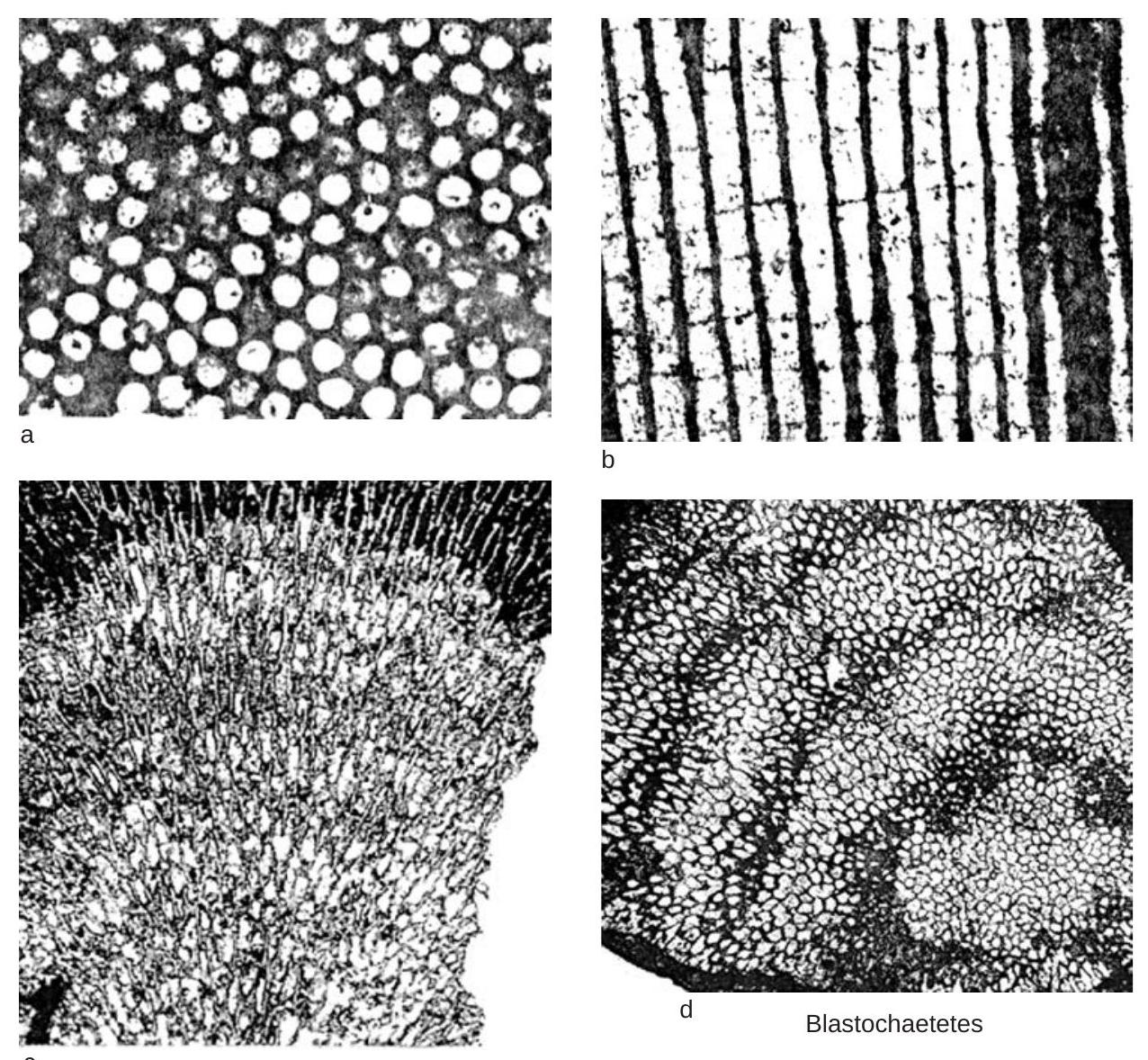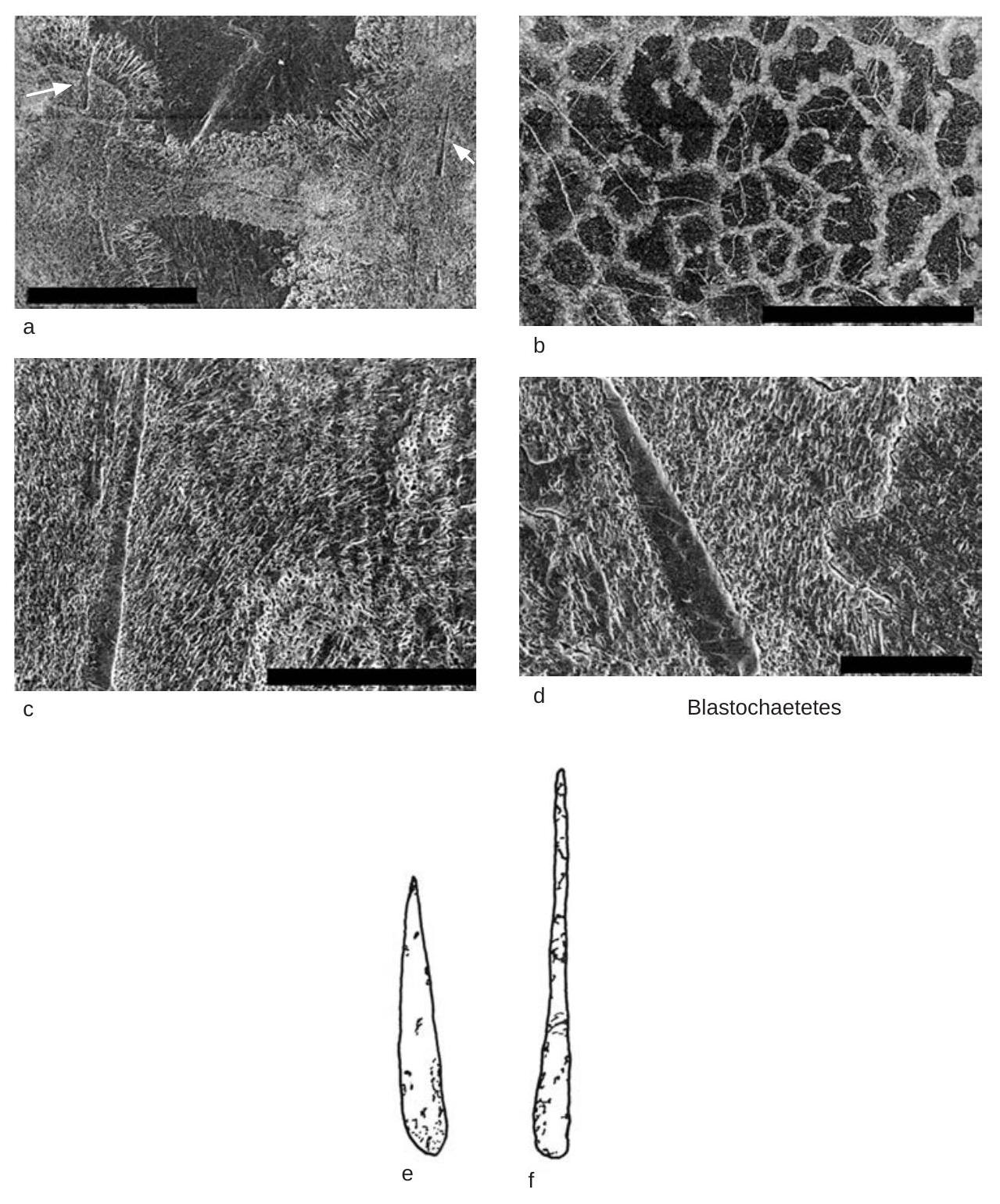Welcome to the Treatise on Invertebrate Paleontology!
Please enter a genera name to retrieve more information.

Blastochaetetes
Classification
Phylum:
Porifera
Class:
Demospongiae
Order:
Demospongiae - Order Uncertain
Family:
Demospongiae - Order and Family Uncertain
Formal Genus Name and Reference:
Blastochaetetes DIETRICH, 1919, p. 210
Type Species:
Chaetetes capilliformis MICHELIN, 1844 in 1840-1847, p. 112, OD
Images
(Click to enlarge in a new window)
Fig. 191a-b. *B. capilliformis (Michelin), Tithonian, France, unnumbered specimens, a, transverse section of basal skeleton, X20, b, longitudinal section of basal skeleton, X20 (Peterhans, 1929b, pl. VI)., FIG. 191c-d. B. dolomiticus Bizzarini & Braga, Norian, Tilkideligi Tepe and B., Alankoyu, Turkey, c, longitudinal section of basal skeleton, specimen TTR/1a, X3.8, d, transverse section of basal skeleton, specimen TTM12, X2.6 (Cremer, 1995, p. 170, pl. 26)., FIG. 192a-f. B. dolomiticus Bizzarini & Braga, Norian, Tilkideligi Tepe and B., Alankoyu, Turkey, a, tabula between tubule walls, white arrows indicate tylostyle megascleres embedded in primary wall of specimen TTR/1a, X130, b, irregular tubule shape and pseudosepta in transverse section of specimen TTH12, X16.5, c, penicillate, water-jet (fascicular fibrous) microstructure of primary tubule walls, with embedded slender, tylostyle megasclere, X400, d, unnumbered specimen with short clublike tylostyle megasclere, X900, e-f, diagrammatic sketches of tylostyle megascleres from an unnumbered specimen, X750, X675 (Cremer, 1995, p. 170, pl. 26).
Synonyms
Geographic Distribution
Italy, Turkey, Carnian-Norian; France, Italy, Spain, Jurassic (Tithonian)-Upper Cretaceous
Age Range
Beginning Stage in Treatise Usage:
Triassic (Carnian)
Beginning International Stage:
Carnian
Fraction Up In Beginning Stage:
0
Beginning Date:
237
Ending Stage in Treatise Usage:
Upper Cretaceous
Ending International Stage:
Maastrichtian
Fraction Up In Ending Stage:
100
Ending Date:
66.04
Description
Growth form domical to columnar (possible branching); tubules polygonal in transverse section, filled with drusy calcite, pseudosepta present, tubules long, diameter varies, imperforate, tabulae thin, horizontal or slightly tilted, irregularly placed, tubules increase by intertubular budding, rarely by longitudinal fission, aragonite or Mg calcite inferred original mineralogy. [Dietrich (1919) based his genus on specimens from the Oxfordian of Chatel-Censoir, Yonne, France, that he referred to Michelin’s species; Dietrich’s types were interpreted by Fischer (1970) as a new species of Bauneia, and if Dietrich’s description of his specimens is taken as his designation of them as types, then Blastochaetetes would become a senior synonym of Bauneia Peterhans, 1927. However, Fischer recognized Chaetetes capilliformis Michelin, 1844 in 1840–1847, p. 112 (in Michelin ColIection of the NMNH, Paris, Oxfordian, Jurassic, Saint Mihiel, Meuse, France) as the type specimen; fide Hill, 1981, p. 519. Whereas neither microstructure and spicules nor spicule pseudomorphs have been recognized in the type species, another species exhibits some of these details. Bizzarini and Braga (1978, p.44–46) first described Blastochaetetes dolomiticus from the Carnian Dolomite Alps of Italy (holo-type MIGUP no. 26064; paratypes MIGUP nos. 28=6065-66), and Cremer (1995, p. 170–172) provided a more complete diagnosis and description of B. dolomiticus, based on specimens from the Norian of Turkey, in the Cremer collection in the Paleontological Institute, University of Erlangen-Nurnberg, IPE): growth form domical to conical, growth bands distinct; in transverse section, tubules irregular polygons, vary in size and shape with pseudsepta; tubule walls with knoblike thickenings in longitudinal section; tabulae frequent, plain to concave, often with thickened margins, irregularly spaced; tubules increase by intertubular budding and longitudinal fission; primary wall layer penicillate, water-jet (fascicular fibrous) microstructure; secondary wall layer thin, epitaxial fibrous calcite; calcite pseudomorph tylostyle megascleres (49–109 µm long) long, slender, and short, club shaped in both primary and secondary wall layers, lacking preferred orientation; microscleres unknown (description adapted from Cremer, 1995, p. 170–172).]
References
Dietrich, W. O. 1919. Über die sogennante Tabulaten des Jura und der Kreide, insbesondere die Gattung Acantharia Qu. Zentralblatt für Mineralogie, Geologie und Paläontologie 1919:208-218, 2 fig.
Museum or Author Information
Classification
Phylum:
Porifera
Class:
Demospongiae
Order:
Demospongiae - Order Uncertain
Family:
Demospongiae - Order and Family Uncertain
Formal Genus Name and Reference:
Blastochaetetes DIETRICH, 1919, p. 210
Type Species:
Chaetetes capilliformis MICHELIN, 1844 in 1840-1847, p. 112, OD
Images
(Click to enlarge in a new window)
Fig. 191a-b. *B. capilliformis (Michelin), Tithonian, France, unnumbered specimens, a, transverse section of basal skeleton, X20, b, longitudinal section of basal skeleton, X20 (Peterhans, 1929b, pl. VI)., FIG. 191c-d. B. dolomiticus Bizzarini & Braga, Norian, Tilkideligi Tepe and B., Alankoyu, Turkey, c, longitudinal section of basal skeleton, specimen TTR/1a, X3.8, d, transverse section of basal skeleton, specimen TTM12, X2.6 (Cremer, 1995, p. 170, pl. 26)., FIG. 192a-f. B. dolomiticus Bizzarini & Braga, Norian, Tilkideligi Tepe and B., Alankoyu, Turkey, a, tabula between tubule walls, white arrows indicate tylostyle megascleres embedded in primary wall of specimen TTR/1a, X130, b, irregular tubule shape and pseudosepta in transverse section of specimen TTH12, X16.5, c, penicillate, water-jet (fascicular fibrous) microstructure of primary tubule walls, with embedded slender, tylostyle megasclere, X400, d, unnumbered specimen with short clublike tylostyle megasclere, X900, e-f, diagrammatic sketches of tylostyle megascleres from an unnumbered specimen, X750, X675 (Cremer, 1995, p. 170, pl. 26).
Synonyms
Geographic Distribution
Italy, Turkey, Carnian-Norian; France, Italy, Spain, Jurassic (Tithonian)-Upper Cretaceous
Age Range
Beginning Stage in Treatise Usage:
Triassic (Carnian)
Beginning International Stage:
Carnian
Fraction Up In Beginning Stage:
0
Beginning Date:
237
Ending Stage in Treatise Usage:
Upper Cretaceous
Ending International Stage:
Maastrichtian
Fraction Up In Ending Stage:
100
Ending Date:
66.04
Description
Growth form domical to columnar (possible branching); tubules polygonal in transverse section, filled with drusy calcite, pseudosepta present, tubules long, diameter varies, imperforate, tabulae thin, horizontal or slightly tilted, irregularly placed, tubules increase by intertubular budding, rarely by longitudinal fission, aragonite or Mg calcite inferred original mineralogy. [Dietrich (1919) based his genus on specimens from the Oxfordian of Chatel-Censoir, Yonne, France, that he referred to Michelin’s species; Dietrich’s types were interpreted by Fischer (1970) as a new species of Bauneia, and if Dietrich’s description of his specimens is taken as his designation of them as types, then Blastochaetetes would become a senior synonym of Bauneia Peterhans, 1927. However, Fischer recognized Chaetetes capilliformis Michelin, 1844 in 1840–1847, p. 112 (in Michelin ColIection of the NMNH, Paris, Oxfordian, Jurassic, Saint Mihiel, Meuse, France) as the type specimen; fide Hill, 1981, p. 519. Whereas neither microstructure and spicules nor spicule pseudomorphs have been recognized in the type species, another species exhibits some of these details. Bizzarini and Braga (1978, p.44–46) first described Blastochaetetes dolomiticus from the Carnian Dolomite Alps of Italy (holo-type MIGUP no. 26064; paratypes MIGUP nos. 28=6065-66), and Cremer (1995, p. 170–172) provided a more complete diagnosis and description of B. dolomiticus, based on specimens from the Norian of Turkey, in the Cremer collection in the Paleontological Institute, University of Erlangen-Nurnberg, IPE): growth form domical to conical, growth bands distinct; in transverse section, tubules irregular polygons, vary in size and shape with pseudsepta; tubule walls with knoblike thickenings in longitudinal section; tabulae frequent, plain to concave, often with thickened margins, irregularly spaced; tubules increase by intertubular budding and longitudinal fission; primary wall layer penicillate, water-jet (fascicular fibrous) microstructure; secondary wall layer thin, epitaxial fibrous calcite; calcite pseudomorph tylostyle megascleres (49–109 µm long) long, slender, and short, club shaped in both primary and secondary wall layers, lacking preferred orientation; microscleres unknown (description adapted from Cremer, 1995, p. 170–172).]
References
Dietrich, W. O. 1919. Über die sogennante Tabulaten des Jura und der Kreide, insbesondere die Gattung Acantharia Qu. Zentralblatt für Mineralogie, Geologie und Paläontologie 1919:208-218, 2 fig.

